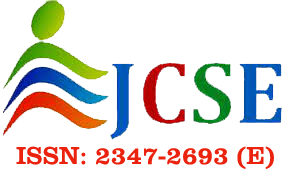Cloud Service Selection Using Integrated Approach Of Fuzzy AHP And Fuzzy Topsis
S. Pavani1 , R. Shukla2
Section:Research Paper, Product Type: Journal Paper
Volume-07 ,
Issue-03 , Page no. 48-54, Feb-2019
Online published on Feb 15, 2019
Copyright © S. Pavani, R. Shukla . This is an open access article distributed under the Creative Commons Attribution License, which permits unrestricted use, distribution, and reproduction in any medium, provided the original work is properly cited.
View this paper at Google Scholar | DPI Digital Library
How to Cite this Paper
- IEEE Citation
- MLA Citation
- APA Citation
- BibTex Citation
- RIS Citation
IEEE Citation
IEEE Style Citation: S. Pavani, R. Shukla, “Cloud Service Selection Using Integrated Approach Of Fuzzy AHP And Fuzzy Topsis,” International Journal of Computer Sciences and Engineering, Vol.07, Issue.03, pp.48-54, 2019.
MLA Citation
MLA Style Citation: S. Pavani, R. Shukla "Cloud Service Selection Using Integrated Approach Of Fuzzy AHP And Fuzzy Topsis." International Journal of Computer Sciences and Engineering 07.03 (2019): 48-54.
APA Citation
APA Style Citation: S. Pavani, R. Shukla, (2019). Cloud Service Selection Using Integrated Approach Of Fuzzy AHP And Fuzzy Topsis. International Journal of Computer Sciences and Engineering, 07(03), 48-54.
BibTex Citation
BibTex Style Citation:
@article{Pavani_2019,
author = {S. Pavani, R. Shukla},
title = {Cloud Service Selection Using Integrated Approach Of Fuzzy AHP And Fuzzy Topsis},
journal = {International Journal of Computer Sciences and Engineering},
issue_date = {2 2019},
volume = {07},
Issue = {03},
month = {2},
year = {2019},
issn = {2347-2693},
pages = {48-54},
url = {https://www.ijcseonline.org/full_spl_paper_view.php?paper_id=677},
publisher = {IJCSE, Indore, INDIA},
}
RIS Citation
RIS Style Citation:
TY - JOUR
UR - https://www.ijcseonline.org/full_spl_paper_view.php?paper_id=677
TI - Cloud Service Selection Using Integrated Approach Of Fuzzy AHP And Fuzzy Topsis
T2 - International Journal of Computer Sciences and Engineering
AU - S. Pavani, R. Shukla
PY - 2019
DA - 2019/02/15
PB - IJCSE, Indore, INDIA
SP - 48-54
IS - 03
VL - 07
SN - 2347-2693
ER -
Abstract
Cloud computing has emerged as a new computing platform for providing fast and low cost services to the individual ,organizations ,government etc. over the internet and is a future generation technology. Cloud computing model means to increase the opportunities for cloud user by accessing leased infrastructure and software application from anywhere and anytime manner. Cloud computing mainly consist there service model as Software as a Service (Saas), Platform as a Service (PaaS) and Infra structure as a Service (IaaS). These service models are being provided by many cloud services provider and a user can choose any one of them based on various parameters .which many differ from one service provider to another service provider and is a challenging and tedious task for an end user to select the best one. This paper provides an approach to select cloud services among the available alternatives to the IT users using two popular Multi Criteria Decision Making (MCDM) Techniques: Fuzzy Analytical Hierarchy Process (FAHP) and Fuzzy Technique for Order Preference by Similarity to Ideal Solution(FTOPSIS) with special reference to triangular fuzzy membership function for experimental hypothetical alternatives as and services are considered with identified criteria. Selection process MCDM techniques are enough capable to find out the best alternatives as cloud service, a hypothetical cloud services as alternatives, used on identified criteria where ranked and found satisfactory.
Key-Words / Index Term
Cloud services, Fuzzy analytic hierarchy process (FAHP), Fuzzy technique for order preference by similarity to ideal solution
References
[1] R. Buyya, C.S. Yeo, S. Venugopal, J. Broberg, and I.B. Randic, “Cloud computing and emerging IT platform: vision, hype, and reality for delivering computing as the 5thutility”,Future Generation Computing system,Vol.25,No. 6,pp.599-616,2009.
[2] R. Buyya, C.S. Yeo, S. Venugopal, “Market-Oriented Cloud Computing: Vision, Hope, and Reality for Delivering IT services as computing Utilities”, IEEE,2008
[3] O. Boutkhoum, M. Hanine and T. Agouti, “Selection problem of cloud solution for big data accessing: fuzzy AHP-PROMETHEE as a proposed methodology”, JDIM,2016.
[4] S. K. Garg, S. Versteeg and R. Buyya,“A framework for ranking of cloud computing services”, Elsevier,2013.
[5] A.C. Kutlu, M. Ekmekcioglu, “Fuzzy failure modes and effects analysis by using fuzzy TOPSIS-based fuzzy AHP”, Expert Systems with Applications, Elsevier, Vol.39, pp. 61–67,2012.
[6] S. Pearson, “Taking Account of privacy when Designing Cloud computing Services”, HP Laboratories,2009.
[7] R.V. Rao, “Decision making in the manufacturing environment”, Springer-Verlag London Limited,2007.
[8] S.S. Kaur, Y. Brar And K.N. Singhand, “Multi Criteria Decision Making Approach for Selecting Effort Estimation Model”,International Journal of Computer Applications (0975 – 8887),Volume 39– No.1,pp.10-17,2012
[9] T.L. Satty, “The Analytical Hierarchy Process”, McGraw Hill, New York ,1980.
[10] G. Wei, A.V. Vasilakos, Y. Zheng And N. Xiong, “A game –theoretical method of fair resource allocation for cloud computing services”, Springers ,2009.
[11] M. Whaiduzzaman, A. Gani, N.B. Anuar, M. Shiraz, M.N. Haque and I.T. Haque, “Cloud services selection using multicriteria decision analysis”, The Scientific world Journal volume, article ID pp.459-3375,2014.
[12] Qi. Zhang, Lu. Cheng, R. Boutaba, “Cloud computing: state- of- the- art and research challenges”, Springers,2010.
